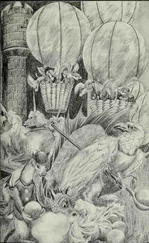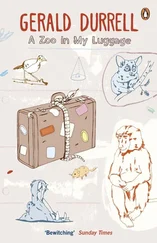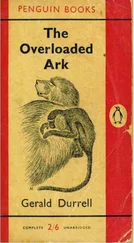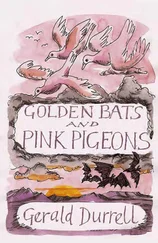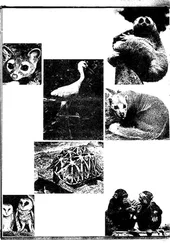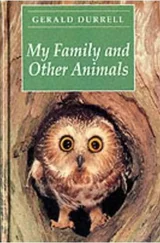The one reptile-house inhabitant that never seemed to become overweight, no matter how much he ate, was our dragon, known as George. He was a Guiana dragon, a rather rare and interesting kind of lizard from the northern parts of South America. They measure about two feet six inches in length, and have large, heavy heads with big, dark, intelligent eyes. The body and tail are very crocodile-like in appearance, the tail being heavily armoured and flattened on top, whereas the back is covered with heavy scales which are bean-shaped and protrude above the surface of the skin. The colouring is a warm rusty brown, fading to yellowish on the face. They are slow, thoughtful, and attractive lizards, and George had a very mild and likeable character.
Probably one of the most remarkable things about Guiana dragons are their feeding habits. Before George arrived we had read up all we could on the species, but none of the textbooks were very helpful. However, they seemed to be perfectly normal lizard-type creatures, and so we thought that their diet would be similar to that of any large carniverous lizard. When George arrived he was petted, admired, and placed reverently in a large cage prepared for him, with a special pond of his own. This amenity he appeared to appreciate fully, for the moment he was released into his quarters he made straight for the pond and plunged in. He spent half an hour or so squatting in the water, occasionally ducking his head beneath the surface for a few minutes at a time and peering thoughtfully about the bottom of the pond. That evening we gave him a dead rat, which he regarded with considerable loathing. Then we tried him on a young chicken with the same result. Fish he retreated from as if it were some deadly poison, and we were in despair, for we could think of nothing else that he might like.
Just when we were convinced that George was going to starve himself to death, Shep had an idea. He fetched a handful of fat garden snails and tossed them into George’s pond. George, who had been sitting on a tree trunk at the back of the cage looking very regal, eyed this floating frothing largesse with his head on one side. Then he came down to the pool, slid into the water, and nosed at a snail, while we watched hopefully. Delicately he picked up the snail in his mouth and, throwing back his head, allowed it to slide to the back of his mouth. Now that his mouth was open I could see that he had the most astonishing teeth I had ever seen in a lizard: teeth that were, of course, perfectly adapted for eating snails. Those in front were fairly small, pointed, and inclined slightly backwards. These were the grasping teeth, as it were. Once they had hold of the snail, the lizard threw back his head so that the mollusc slid and rested on the teeth at the back of the mouth. These were huge, shoebox-shaped molars with carunculated surfaces which looked more like miniature elephants’ teeth than anything else. With the aid of his tongue, George manoeuvred the snail until it rested between these ponderous molars, and then closed his jaws slowly. The snail cracked and splintered, and when he was quite sure that the shell was broken he shifted the whole into the centre of his mouth and, by careful manipulation of his tongue, extracted all the bits of broken shell and spat them out. Then the smooth, shell-less body of the snail was swallowed with every evidence of satisfaction. The complete process took about a minute and a half, after which George sat there for a bit, licking his lips with his black tongue, and musing to himself. After a time he leaned forward and daintily picked up another snail, which he dispatched in the same manner. Within half an hour he had eaten twelve of these molluscs, and we were jubilant, for, having now discovered George’s preference, we knew there would be no more difficulty in keeping him.
It is always a relief when a reptile starts to feed itself, for if it refuses food for a certain length of time it has to be force-fed, and that is a tricky and unpleasant job. Many of the constricting snakes refuse food on their arrival, and have to be force-fed until they have settled down, but it is not an operation one relishes, since, with their fragile jaws and teeth, it is very easy to break something and thus set up an infection in the mouth. I think the worst force-feeding job we ever had was with a pair of young gavials, or gharials. These are Asiatic members of the crocodile family, and in the wild state feed on fish. Instead of the strong, rather blunt jaws of the alligators and crocodiles, the gavial’s jaws are long and slender, resembling a beak more than anything. Both the jaws and the teeth are fragile, the teeth especially so, for they appear to fall out if you look at them. In consequence, when our two young gavials arrived and steadfastly refused all food, including live fish in their pond, our hearts sank, as we realized we would have to force-feed them. The process was tedious, protracted and difficult, and had to be done once a week for a year before the gavials would feed on their own. First, you take a firm grip on the back of the creature’s neck and his tail. Then you lift him out of the tank and place him on a convenient flat surface. Whoever is helping you then slides a flat, smooth piece of wood between the jaws at the back of the mouth, immediately behind the last teeth. When the jaws are prised a little apart, you slightly release your grip on the reptile’s neck and slide your hand forward, push your thumb and forefinger between the jaws, and hold them apart. This is generally much easier than it sounds. The other person then arms himself with a long, slender stick and a plateful of raw meat chunks or raw fish. He impales a piece of meat or fish on the end of the stick, inserts it into the reptile’s mouth, and pushes it towards the back of the throat. This is the tricky part, for in all members of the crocodile family the throat is closed by a flap of skin; this arrangement allows the creature to open its mouth beneath the surface without swallowing vast quantities of water. The food has to be pushed past this flap of skin and well down into the throat. Then you massage the throat until you feel the food slide down into the stomach. As I say, it is a tedious task, as much for the gavial as for you.
By and large, the creatures that seem to cause the least trouble in the reptile house are the amphibians. They usually feed well, and they do not seem to suffer from the awful variety of cankers, sores, and parasites that snakes and lizards contract, though I must admit they can come up with one or two choice complaints of their own on occasion, just to enliven things for you. The pipa toads were a good example of this. These extraordinary creatures come from British Guiana, and look, quite frankly, like nothing on earth. Their bodies are almost rectangular, with a leg at each corner, so to speak, and a pointed bit between the front legs that indicates where the head is supposed to be. The whole affair is very flattened and a dark blackish brown colour, so the creature looks as though it had met with a nasty accident some considerable time ago and has been gently decomposing ever since. The most extraordinary thing about these weird beasts is their breeding habits, for the pipa toads carry their young in pockets. During the breeding season the skin on the female’s back becomes thickened, soft, and spongy, and then she is ready for mating. The male clasps her, and as soon as she is ready to lay she protrudes a long ovipositor which curves up onto her back, underneath the male’s stomach. As the eggs appear, he fertilizes them and presses them into the spongy skin of the back. They sink in until only a small proportion of the egg is above the surface. This exposed portion of egg hardens. So inside their individual pockets the tadpoles undergo their entire metamorphosis until they change into tiny replicas of their parents. When they are ready to hatch, the hardened top of the shell comes loose, and the tiny toads push it back and climb out, looking rather like someone getting out of a bubble car.
Читать дальше

